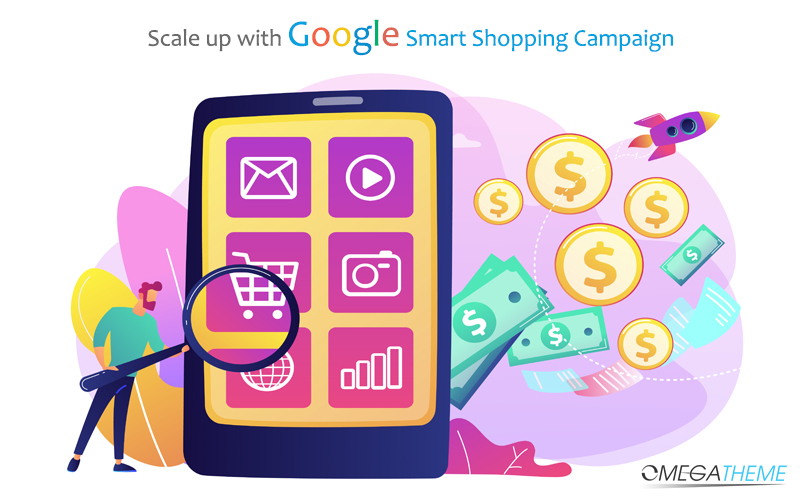
Apparently, it’s a big advantage to run ads on Google, however, you need to make sure that you match Google’s requirements to run shopping campaigns and here’s the list:
- Having a Google Merchant Center (GMC) account
- Your product feed on GMC has been approved. Check out FeedNexa Google Shopping Feed to create product feed for free
- You are using conversion value tracking
- You have set up your tag for dynamic marketing, this tag must have at least 100 active users.
- Preparing general marketing assets for those who have visited your website but not seen any specific products including one marketing image with size 1.91:1, one long headline, one short headline, one description with 90 characters limit, and one final landing page URL.
Once you have checked through all the requirements, you can create a smart shopping campaign for your products. Please note that your advertising group of products must historically have at least 100 conversions in the last 30 days.
Step by step of how to set up a smart shopping campaign
Getting all the points thoroughly will help you create a better shopping campaign and reach your target easier.
Step 1: Determine your business goals
Understanding and determining clearly your business goals before setting up a campaign is crucial.
There are some goals that majority of retailers are using on their campaign:
- Maximize revenue: If you have similar types of product and have the same sales target, combining those items into a single shopping campaign to drive sales and maximize conversion volume efficiently.
- Maximize profits: use when you have different product categories and set up different profitability goal
- Maximize visibility for best selling products or new products: needs to set the budget specifically for these items with very low return on ad spend (ROAS) target so that the algorithm will spend as much as possible for them to receive the traffic and visibility.
Step 2: Understand guiding principles of machine learning
If your campaign too narrowly maps your business goals, it will reduce the optimization ability of smart shopping campaign’s algorithm because it does not have enough data to work properly.
To avoid this, please consider the following suggestions:
- Avoid over-segmentation: only set up separate campaigns if you business goals require it, you should not create too many shopping campaigns
- Avoid product groups with fewer than 20 conversions in a 15-day period, the more conversion, the better data that algorithm can use to optimize your campaigns.If your product groups have high conversion such as +100 per month, it will perform well.
Step 3: Create a smart shopping campaign
- Logging in your Google Ads account.
- Create a smart shopping campaign by clicking the plus button on the left
- Select Shopping
- Select your Merchant Center account and country of sale
- Select Smart Shopping campaign
- Set budget: The budget that you set should be 20 times greater than cost per action (CPA) that you would like to achieve
For example, your CPA for a product is $50, you should set the budget to $1000
- Set target ROAS: if you leave it blank, the default system will set the target ROAS is 200%, however, if you need to let the machine get as much data as possible first or you need to sell more products without a high level of return, you can set the target ROAS smaller than 200%, such as 120% or 150%, then increase later.
- Select all products: remember the products that you choose must have at least 100 conversions in the last 30 days
- Add creative assets: your logo, marketing assets mentioned at the beginning of this blog.
Step 4: Design your winning strategy
To adjust your strategy, you can use the Product Group report in Google ads. By opening Google Ads -> Reports -> Predefined reports -> Shopping -> Product Type
Then you can see if certain types of products have generated better returns on the other through the numbers showing in “Conv. value/ cost” column.
If you see a product outstand the other, you can set a different campaign with different ROAS for it to optimize, but if the numbers are similar to each other, you should not separate campaigns. To adjust any campaign, it is important to notice the learning period so that you will not interrupt the algorithm.
Smart shopping campaign can take up to 15 days to stabilize, check the table below to know exactly when to adjust and evaluate your shopping campaign performance.

Conclusion
Understanding how Smart Shopping works will give advertisers a better vision and know where to start from to test a campaign performance and gain a better result. The automation of Google Smart Shopping can be an extremely painful thing for online sellers who want to have good management on every aspect of the campaign, however, it offers you a leg up in getting started.
Even though smart shopping has covered many optimization jobs, there are still some best practices that you need to consider to optimize your campaigns and archive the best performance.
If you want to install Google Tag Manager on your Shopify store and track google conversion, check out this app for free TagFly Google Tag Tracking GTM
